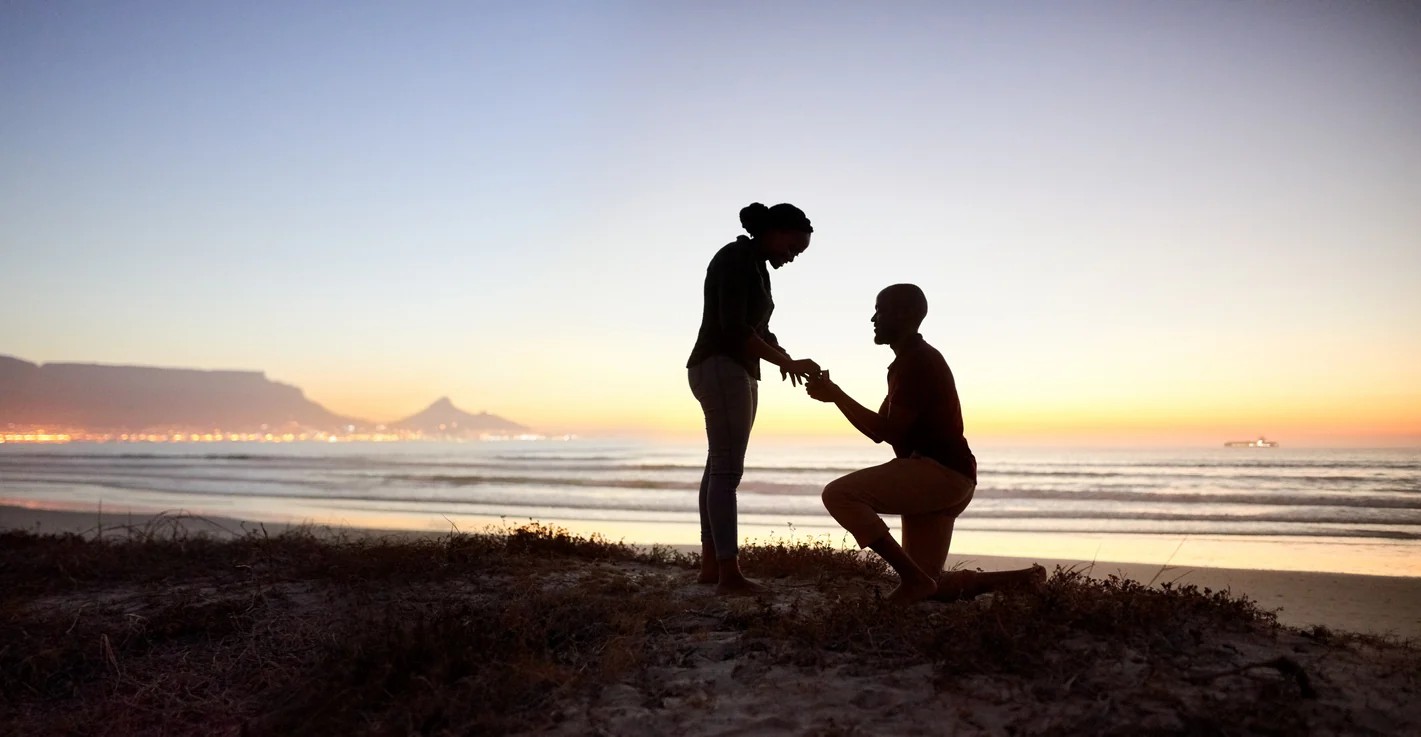- December, with its romantic allure, is known as the peak time for marriage proposals.
- It’s a season where engagements bloom, as people take advantage of the warmth of family gatherings and the magical atmosphere to pop the all-important question.
As the holiday season approaches, Christmas cheer fills the air, and for many, it brings not just festive lights and joyful carols, but also the anticipation of wedding ceremonies. December, with its romantic allure, is known as the peak time for marriage proposals.
It’s a season where engagements bloom, as people take advantage of the warmth of family gatherings and the magical atmosphere to pop the all-important question. But behind these modern declarations of love lies a rich history of tradition, particularly the timeless gesture of men kneeling on one knee and the offering of rings. What might seem like a simple, heartfelt act today is rooted in centuries of cultural significance.
The Tradition of Going Down on One Knee
The act of kneeling dates back to the medieval era, when knights would bend the knee before royalty or in ceremonies of respect. It was a gesture of humility, reverence, and submission, indicating loyalty and service.
This same symbolism has evolved into marriage proposals, where the man’s act of going down on one knee represents a blend of chivalry and devotion. He is, in essence, saying that he is willing to serve and honour his partner, placing their love above his own pride.
Read More
This imagery of a "knight in shining armour" is not just a romantic metaphor but also a nod to the historical roots of this gesture. When a man kneels before his beloved, he embodies the chivalric ideals of old—offering himself as a protector and pledging loyalty.
It is a tradition that, despite shifting gender roles and changing societal norms, continues to resonate deeply in many cultures. For some, this act still holds the magic of courtly love, turning the proposal into a fairy-tale moment.
The Symbolism of the Ring: A Circle of Endless Love
A marriage proposal would be incomplete without a ring—another tradition that carries with it centuries of meaning. The exchange of rings has roots in ancient Egypt, where circles were seen as symbols of eternity, without beginning or end.
The Egyptians believed that a ring symbolized endless love and the promise of forever, a belief that was carried forward through the ages. In ancient Rome, the tradition evolved, and betrothal rings were made of iron, representing strength and durability.
By the time of the Renaissance, diamond rings became popular in Europe, their sparkle symbolizing the fire and passion of true love. The diamond’s unbreakable nature was seen as a fitting representation of a bond that is meant to last.
Today, diamonds remain a popular choice, though other precious stones and even simple bands have also gained favor, allowing couples to tailor the tradition to their unique stories.
Yet, regardless of the type of ring, its significance remains unchanged: it is a tangible promise of love, commitment, and a shared future. When a man presents a ring during a proposal, he is offering more than just a piece of jewelry; he is giving a symbol of his vow to remain steadfast, to cherish, and to honor the relationship.
It is this deep-rooted symbolism that makes the moment so profound, turning a simple piece of jewelry into a cherished heirloom that carries the weight of a promise.
The modern concept of marriage proposals as intimate, romantic gestures is a relatively recent phenomenon. Historically, marriage was more of a contractual arrangement, often decided by families to secure alliances or to ensure economic stability. Proposals as we know them, where the man takes the initiative to ask his beloved’s hand in marriage, only gained popularity in the 19th century with the rise of romanticism.
This era, characterized by an idealization of love, nature, and emotion, saw a shift in how society viewed relationships. The idea of choosing a life partner based on mutual affection rather than convenience or family pressure became more widely accepted. It was during this time that public displays of love, like going down on one knee to propose, became a cherished ritual.
The gesture has since endured, with slight variations across cultures and time periods. In some societies, both partners kneel as a symbol of mutual respect and equality. In others, elaborate ceremonies accompany the proposal, weaving in local customs and traditions. However, the core sentiment remains the same: a public declaration of a private commitment.
In today’s world, gender roles are constantly being redefined, and the traditions of marriage proposals have evolved alongside them. While the classic image of a man on one knee still dominates, many couples are now choosing to forgo traditional gender expectations.
Some women propose to their partners, or couples decide to propose to each other as a sign of mutual commitment. These modern variations highlight how the essence of a proposal—love and commitment—transcends any one way of expressing it.
Yet, the allure of tradition remains strong. Many still feel that there is something magical in the time-honored ritual of a man kneeling down, offering a ring, and asking that timeless question. It is a moment steeped in symbolism and history, connecting couples to a long lineage of lovers who have made the same pledge before them.
As Christmas approaches, and the holiday spirit warms our hearts, many will seize the opportunity to create memories that last a lifetime with a proposal. Whether it's beneath the glow of a Christmas tree, on a snow-covered hill, or during a quiet, candle-lit dinner, the act of proposing is a moment that transcends words. It’s a nod to tradition—a way of saying, “I choose you, now and forever.”
The knightly act of kneeling and the timeless gift of a ring both serve as reminders that some traditions, despite their ancient origins, still hold a special place in our lives. They remind us that love is not just about the present moment but also about a shared history and a commitment to the future.
In the end, whether you see it as an old-world formality or a romantic gesture, the ritual of proposing remains a beautiful way to begin a new chapter with the person you love.
After all, every knight needs a kingdom, and every love story deserves its moment of chivalry—a promise sealed with a ring and a vow made on bended knee.












